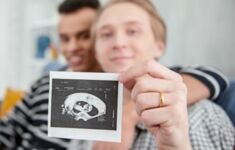New study points the way for gay men to have babies using DNA from both partners
Researchers at the Oregon Health & Science University used a skin cell to adapt an egg.


New research to tackle infertility again suggests it’s possible to convert skin cells into egg cells. The technique uses the same method to create Dolly, the cloned sheep, some 20 years ago.
Although researchers say a practical use is at least ten years away, they believe it could help infertile couples and women unable to produce eggs.
It could also be used by two men to create an embryo using both their DNA. This would then be carried to term by a surrogate mother.
How about we take this to the next level?
Subscribe to our newsletter for a refreshing cocktail (or mocktail) of LGBTQ+ entertainment and pop culture, served up with a side of eye-candy.
At present, gay male couples wanting a biological child of their own will need an egg from a donor. This has DNA from the biological egg donor. Semen from one of the men then fertilizes the egg.
Oregon study
Researchers at the Oregon Health & Science University (OHSU) have undertaken this new study. The results appeared in the journal Science Advance.
They undertook the process, known as in vitro gametogenesis (IVG), in mice.
They removed the nucleus from a skin cell. That’s the important part of the cell that carries all its genetic information. They then placed it in a donor egg cell which had its own nucleus removed.
According to an OSHU press statement, “The investigators coaxed the skin cell’s nucleus into reducing its chromosomes by half, so that it could then be fertilized by a sperm cell to create a viable embryo.”

“The goal is to produce eggs for patients who don’t have their own eggs,” said senior author, Dr. Shoukhrat Mitalipov, director of the OHSU Center for Embryonic Cell and Gene Therapy.
One of the key elements of the process is the skin cell nucleus dividing into two when introduced to the egg cell. In some cases, its chromosome pairs split perfectly in two. However, this wasn’t always the case. The process must be refined to avoid genetic abnormalities occurring in the resulting embryo.
OHSU scientists demonstrated proof of concept in a previous report published in 2022. “This publication basically shows how we achieved [it],” said Mitalipov.
“In the next phase of this research, we will determine how we enhance that pairing so each chromosome pair separates correctly.”
Mouse pups produced in Japan
Other researchers have been looking at how to take a stem cell—the most basic, embryonic type of human cell that has yet to develop into a specific type of cell (brain, muscle, liver, etc)—and turn them into egg or sperm cells. OSHU says its process skips that challenge.
Another member of the OSHU team says the technique requires a few years more of analysis.
“This gives us a lot of insight,” said Paula Amato, M.D., professor of obstetrics and gynecology. “But there is still a lot of work that needs to be done to understand how these chromosomes pair and how they faithfully divide to actually reproduce what happens in nature.”
The Oregon study follows up a similar study published by Japanese researchers last year. They managed to create mouse pups using the DNA from two male mice. However, that was via a slightly different technique that reprogrammed male skin cells into stem cells.
Related:
New scientific breakthrough could pave the way for two men to have biological babies together
Cells from two male mice have created a baby without the use of an egg from a female.

 Mark
Mark 






